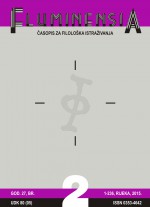COMMUNICATION AND GRAMMATICALIZATION. THE CASE OF (CROATIAN) DEMONSTRATIVES
Keywords:
demonstratives, grammaticalization, universals, cognitive semanticsAbstract
The focus of this paper is on the role that shared reference plays in communication and, relatedly, on the way in which communicative needs drive the formation and development of grammatical categories. The system used to illustrate and analyse the theoretical positions addressed in the paper is that of Croatian demonstratives, a three-way paradigm which – it is claimed – helps us identify the cognitive elements underlying the anchoring of shared reference. In the first part of the paper we explore the pointing gesture from the perspectives of developmental psychology, language acquisition and that of cognitive and linguistic universals. We observe that communicative pointing is a universal communicative device found in all cultures which serves to refer, locate in space or indicate direction of motion. In fact, pointing has been recognized as one of the earliest and most common mechanisms for establishing joint reference. Next, we explore the possible ways in which communicative pointing might have influenced the formation of ‘pointing words’ i.e. demonstratives. A continuum of referential devices is identified: from direct pointing with gesture, direct (pro)nominal pointing, via referentiality through (adjectival and adverbial) modification, all the way to discoursal pointing. We investigate the communicative sequence that takes us from the pointing gesture to various types of ‘pointing words’ (see Diessel, 2006), by exploring the underlying linguistic and, possibly, cognitive universal elements and domains. In final analysis the identified sequence is put into relation with the referential (identificational), via the modificational (qualificational), to the predicative (informative) segments of language.

